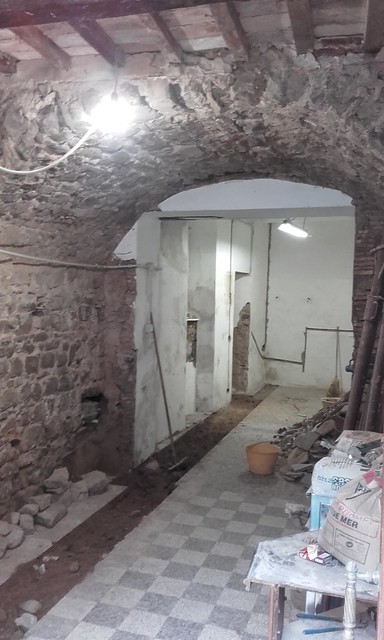Life in Montegiovi
This part of Tuscany is full of little medieval villages perched on top of hills. If we wanted to see all of them we’d never get to Siena in a month! So we take pot-luck and stop at Montegiovi. We park Emma just off the bypass and take the bicycles to zoom down the hill through the olive groves and back up the other side to the village. We come past a garden full of sculptures and are just about to stop and talk to the sculptor when we are put off by a couple fighting: an Italian woman shouts from a window in English to her British husband, who retorts with equal venom, and a three year old child on a trampoline is caught in the middle, looking slightly bewildered and lost. As we move on, I reflect on the nature of disagreements. Although there were plenty of disagreements between my parents, I was never subjected to a scene like this in my childhood. Somehow the dissonances between my parents were of a nature I could understand. I had a mother for whom truth and openness were very important and a father for whom, although an honest person too, harmony and peace were ultimately more important than The Truth, so he would look for what he had in common with people, and turn away from what separated him from them. At times, these two approaches were incompatible and led to friction and frustration (mostly on my mother’s part), and this was clear to me from an early age. Curiously enough, I feel I have inherited both my parent’s qualities, so in a way they are not incompatible. I think the linking ingredients are compassion and empathy.
I digress…
We stroll up the cobbled roads of Montegiovi. The houses look reasonably well kept, but there is an air of despondency about the place. Ok, it is Sunday lunch time, but everything looks completely dead and there are no shops in the centre of the village. Coming up towards the church, there is an open door and we hear some noises, so we pop our heads in to find a young man in the process of restoring an old and narrow house.
This used to be his Grandparent’s bar, he says, and he wants to restore it and reopen it as a bar and social centre. In painstaking weekend labour, he pulls away all the plasterwork to find beautiful stone arches and chestnut beams holding up the terracotta tiles of the second floor. He gives us a tour of the house, showing us where he’s discovered hidden rooms and high ceilings that were obscured by plaster board. The second floor has old baskets and large wine and olive bottles everywhere – this is where Dario plans a meeting point for young and old. His grandfather was a basket weaver and Dario’s plan is to keep some of the old tools and baskets to hang in the rooms.
It is great to see the love for his village shining out of Dario’s eyes and his enthusiasm and tenacity to make a change. But when he speaks of the hardship they face to bring this village back to life, his desperation and sense of having been abandoned by the government comes through. A conversation with an older man on our way back to Emma corroborates this feeling. The will of the locals is there, but the hurdles they have to face with regards to legislation and the load they have to bear in terms of taxes is prohibitive. It simply is not worth producing olive oil or wine anymore, for example – by the time all the middle men have been paid, there is only just enough left to pay the taxes. The young Italian workforce leaves the countryside and is replaced by immigrants from Northern Africa.
They still have hope for their village, but it hangs on a thread.
Posted in Uncategorizedwith 1 comment.

